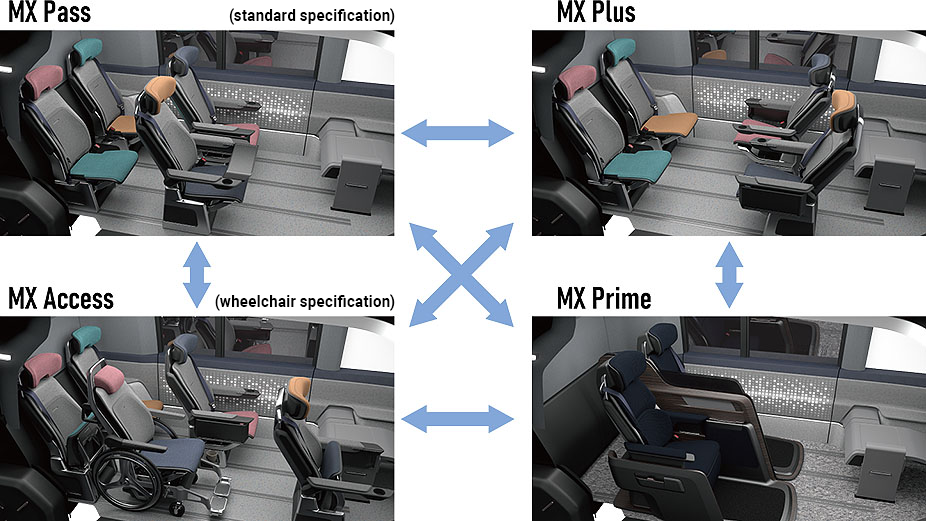Thinking about what it means to be an Interior Space Creator — a round-table discussion among company members

From left:
-
Goro Takahashi
Division General Manager, Interior & Exterior Advanced Development Division Responsible for the management of a division that develops advance interior and exterior components and designs lighting components -
Enoch Morishima
Principal Designer, Toyota Boshoku America Silicon Valley Innovation Hub Responsible for design activities and technology scouting -
Yoshiya Takagi
Senior Specialist, Seat Components Development Division Responsible for planning seat development toward achieving carbon neutrality -
Rina Mukai
Interior Space Planning & Development Division Responsible for planning and development of MX221
Toyota Boshoku is working daily to become an Interior Space Creator by the year 2030. Four company members based on the frontlines talked about what kind of Interior Space Creator our company aims to be.
What will the world look like in the year 2030?
The automotive industry is now entering a once-in-a-century transformational period. Unprecedented changes are taking place as the sector moves toward realizing new technologies and services such as CASE and MaaS. Other sectors outside the automotive field are also facing the urgent need to adopt measures to resolve social issues, including the advance of digital transformation and the spread of renewable energy. We asked each member to share their vision of what society will be like in 2030, the year in which we aim to become an Interior Space Creator.
TakagiI think that in 2030, from a CASE and MaaS perspective, change will only really be evident in a limited number of areas, such as smart cities like Woven City being developed by Toyota Motor Corporation. I believe that things like self-driving buses are becoming more commonplace within such areas.
MukaiPeople’s lifestyles will probably change dramatically and their values will diversify. I think that socially and environmentally conscious products and services will be needed even more than now.
I feel that the value of “owning” things will gradually diminish and the value of “experience” will become more important. I think that by 2030, technology and AI will have evolved even further, and “connected” will be the norm, with the emergence of products and services that have never been seen before.
EnochIn the light of demographic change, I think society’s values will change. It’s said that by 2030, Generation Z will account for about 30% of the working population. For example, they tend to prefer ridesharing rather than owning a vehicle. I think the values of Generation Z will affect the way people and cars are connected, with the entire automotive industry undergoing sweeping change.
TakahashiI can’t say definitively how the world will look, but I can foresee possibilities at both extremes.
It’s possible that breakthrough innovation could occur in the CASE and MaaS fields, but it’s equally possible that it won’t be much different from what we have now. If major innovations are to occur, we must be well attuned so as not to miss out on those opportunities. I think it’s important to consider how quickly we can detect what might happen in the future, and tie that in with development.
At the same time, we also have to anticipate the possibility of negative conditions. We could not have predicted the coronavirus pandemic, for example, and of course we were not prepared for it. Other social issues such as global warming, environmental pollution, declining birthrate and aging society, and large-scale disasters such as major typhoons, torrential rains, and earthquakes may not be something that our company alone can address, but we need to consider what we can do.
What is an Interior Space Creator?
At the 2019 Tokyo Motor Show, the Toyota Boshoku group declared its aim of becoming an Interior Space Creator, creating new value for mobility spaces. As well as their personal view of what it means to be an Interior Space Creator, we asked the members what they feel they can personally do now to make that happen.
TakahashiI think an Interior Space Creator is capable of providing interiors and functions for all kinds of spaces that are comfortable and make people happy — not only for automobiles, but also for spaces such as trains, aircraft, homes, and hospital facilities. Especially for automobiles, we can flexibly handle all forms of development to meet our customers’ needs, from planning to the development, design, and manufacturing of all in-car components. This is conditional on them being high-quality products at an affordable price. Also, I think we should not only provide the “hardware” such as the interior components that make up the space, but also be able to offer total solutions, including “software” such as the system controls that provide comfort for the passengers, for example.
MukaiI think an Interior Space Creator is capable of creating that kind of new value for the entire space, which resonates with people. I’d like to be able to provide the kind of value that enhances people’s lifestyles through the use of space, and enriches their lives through experiences; in other words, to contribute to improving their quality of life. I think the MOOX※1 and MX※2 series demonstrate what it means to be an Interior Space Creator.
I was in charge of planning for the MX221. We focused on proposing the entire interior space, and thought about the value to be provided and the specific functions and solutions to realize that. I had the opportunity to introduce the MX221 to students, along with our aim of becoming an Interior Space Creator, and they were very interested in the work of total coordination of the entire vehicle interior. I was very happy to see many positive responses in the questionnaire that followed, with comments such as “I sensed the future potential of the company,” “It was fascinating,” and “I came away with an even more positive image.” I believe that our activities, which involve making proposals for each space rather than just single items such as seats and interior furnishings, not only provide value to users, but will also lead to the future of Toyota Boshoku.
EnochI think it’s very important for our company to consider interior spaces from a broader perspective. I was the only designer for Toyota Boshoku America in Silicon Valley, and was involved in the development of the MX221. From the concept to the design of the interior space, we discussed the entire vehicle in a collaborative process between the US and Japan. After the overall concept was complete the Japanese development team gave shape to the initial interior concept I had drawn up. MX221 was a very significant project in which the US and Japan worked together as one. I think we should view all kinds of space interiors as potential business opportunities — not just automobiles, but also including railways, aircraft, and housing.
TakagiWhen I joined Toyota Boshoku, I was not really aware of “space proposals.” However, I was told that since we are a company that creates interiors, we ought to be able to make proposals for interior concepts and spaces, which made complete sense to me. Recently, as CASE and MaaS continue to evolve, I’ve felt that our group’s role in making space proposals is really expanding.
- ※1 Mobility as a Service: This is a concept for seamlessly linked new mobility that combines all types of transportation other than personally owned vehicles as one service
- ※2 Abbreviation of “Mobility eXperience.” An automobile interior space model designed for autonomous driving levels 3 and 4.
MaaS rideshare interior space concept, MX221

Assuming that autonomous driving level 4 becomes mainstream after 2030, we propose an interior space for urban area rideshare mobility under the concept theme of “Diversatility*”.
The seat layout and interior items can be altered to meet diverse mobility needs and usage scenarios.
For more information on our value creation initiatives for mobility spaces, including MX221, please visit our innovation website.
https://tech.toyota-boshoku.com/global/
- ※ A term coined by combining the words “Versatility” and “Diversity.” Versatile spaces to suit a variety of users.
What will be important in realizing the company’s target?
We asked the members about their own respective goals and perceptions of the challenges they face in aiming to be an Interior Space Creator, as well as the role they see themselves playing.
TakagiI believe we cannot avoid addressing environmental issues such as carbon neutrality and the circular economy.
Right now, I am involved in work related to the reduction of CO2 emissions in seat production. To achieve carbon neutrality, it is important to identify CO2 emissions throughout the life cycle, including in the supply chain. We start by calculating CO2 emissions, and then consider what innovations we can make in processes where emissions are high.
TakahashiIn the US, I saw automobiles designed with ideas that we would never think of, such as a roof made up of just a sun visor without a front header. For example, now when we create a new design, instead of thinking about the design, first we think about what we need to do to comply with the legal regulations. Ideas based on such a stereotypical approach only produce designs that are bound by convention.
On that point, I am truly amazed at the flexibility of startups. I am keenly aware that in order to create something new, we must think outside the box and free ourselves of all previous experience and accepted practice.
EnochCompetitive startup companies are not necessarily automobile experts, but they do have a strong vision of what they want to do. I think it’s because they don’t stick to conventional approaches but utilize new things keep coming out of Silicon Valley technology companies — and not just in the automotive sector.
We have a long history and a wealth of experience in the automotive field, but we’re not experts in the digital or healthcare fields, for example. In areas outside our expertise, we need to learn and collaborate with other companies through open innovation.
MukaiWith the MX221, five Toyota Group companies worked with us from the planning stage, and we thought about what was the true value of the MX221. The discussion started with us asking them to come up with ideas, irrespective of their own company’s business or products, and from various ideas we got down to actual functions and solutions. Of course it took a lot of effort to put the concept together, but new insights were generated from the diversity of opinions, and we learned a lot.
TakahashiI believe we will get progressively closer to becoming an Interior Space Creator as each company member gains new knowledge and experience through open innovation with external parties, and comes up with novel ideas and technology.
The round-table discussion, which began by connecting the US and Japan, lasted for an hour and a half, and generated a lively exchange of views. The company members who took part will continue with their efforts, from their own individual perspectives, as they take on the challenge of becoming an Interior Space Creator.

 Media site to convey the Toyota Boshoku group vision for the future and initiatives
Media site to convey the Toyota Boshoku group vision for the future and initiatives



